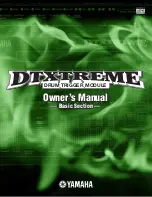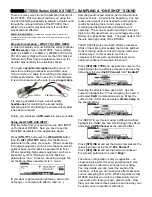
1
11:5 Programming patterns
A guide to drum pattern programming is beyond the scope of this manual - like good melody and harmony parts, there are no
shortcuts to good drum composition! However, here are a few hints and tips to point you in the right direction.
Drumming fundamentals
Consider how a drummer would play a pattern. Most drummers have 2 hands and 2 feet: 4 limbs in total. It therefore logically
follows that generally, up to 4 things can be played at any one time. It’s good to watch a few drumming videos (a good source of
these can be found at drummerworld.com) or study some drum scores to get a better idea of how drum patterns are composed.
Study a few points of drumming rudiments: things like single and double strokes, paradiddles, and so on. Understanding how
drummers build rhythms is vitally important in creating realistic drum parts.
Physical interfacing with the computer
Drumming is a very physical activity! It’s good to play something in real time to capture real spontaneity and groove, instead of us-
ing a mouse on a piano roll.
A keyboard action is not ideal for drumming, as there is a lot of travel required to trigger the note. Keyboard mechanisms were
designed to move hammers that hit strings, not to play drum sounds! It’s better to use something more tactile and responsive like
a drum-pad unit (such as the M-Audio Trigger Finger, Korg PadKontrol, Akai MPD-16/24 etc) or an electronic drum kit.
Transcribe, study and edit existing drum parts
Try to transcribe the drum parts from your favourite records. If you find it difficult to program drums that you can hear with your
ears, then it’s unreasonable to expect yourself to program drums that you can only hear ‘in your head’. The more you practice
drum programming techniques, the more skills you learn. A good way to transcribe a pattern is to import a looping segment of a
song into a track on your sequencer. While looping the part, program the drum sounds until it sounds right, then mute the loop.
Whatever remains should be a reasonable approximation of the drums.
Another valuable resource for study is BFD2’s library of Grooves. Even if the patterns in the Groove library aren’t your cup of tea,
you can study them as MIDI parts in your sequencer to see how a drummer pushes and pulls against the ‘grid’ of hard beat divi-
sions. It’s also a good idea to look at the event velocities, to get a feel for how accenting and velocity variation can help the feel of
a drum pattern.
If you like the feel of a Groove or a Fill but not the actual pattern, it’s very easy to to create new patterns by moving notes ‘up and
down’ to different kit-piece articulations in your sequencer’s piano roll or in BFD2’s Groove editor. Many sequencers also contain
tools for ‘groove quantizing’ – extracting the feel from a MIDI part (such as an exported Groove) and using it as a quantize tem-
plate for other MIDI parts. See your sequencing host’s manual for details of such features.
















































